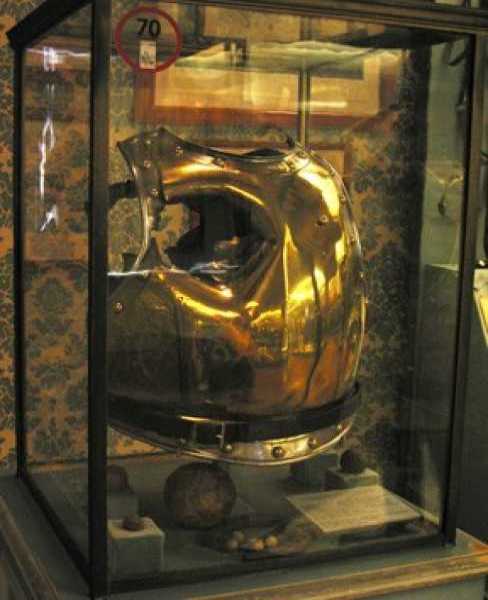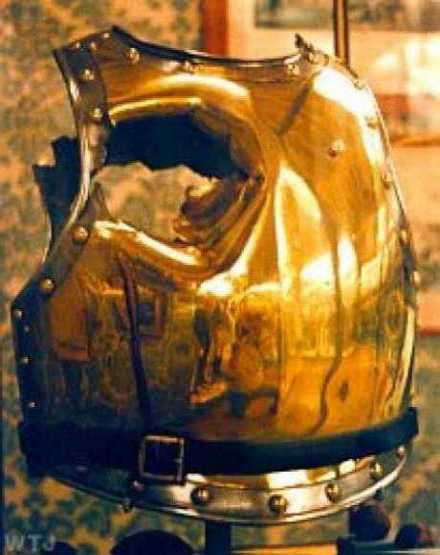Many have probably already seen the pics of this armor on a Napoleonic website, but for some reason this decorative brass plated steel chest armor has interested me ever since I first saw the photos. I don't mean this to be morbid, but if your number is called when you're young, I suppose this would be as good a way to go as any. The Carabinier that wore this cuirass couldn't have had any time to contemplate either pain nor his fate that day on the field at Waterloo, when the six-pound solid shot that made the holes in what is now a museum attraction, took his life.

"The visitor to the army museum at Les Invalides, Paris, who walks into the room devoted to the 1815 campaign and the Restoration is confronted by a dramatic relic taken from the battlefield of Waterloo. In a display cabinet stands a handsome polished cuirass of brass plated steel, expressing the martial glamour of Napoleon’s army – except that a huge hole is punched through both breast and back plates, where a 6-pound cannonball smashed its way through the troopers right breast and shoulder.
The sight of this ruined armor, now engraved with the date ’18 juin 1815’, is extraordinarily moving, and the visitor cannot help but imagine the fate of the 23-year old Carabinier Antoine Francois Faveau, who wore it on that fatal Sunday. He rode with the 2nd Company, 4th Squadron of the 2nd Regiment of Carabiniers – one of only two regiments to wear these gleaming brass-faced cuirasses. Brigaded together, these elite units of the French heavy cavalry of the Line took part in the last desperate charge sent in vain by Marshal Ney against the stubborn British infantry squares. Faveau’s cuirass may stand as an eloquent symbol of despairing courage and sacrifice, and of the final downfall of Napoleon’s empire.
When young Antoine Faveau was torn from his saddle at Waterloo, Napoleon’s Carabiniers had already been fighting on Europe’s battlefields for 20 years."

"The effects of Napoleonic artillery fire on humans could be terrifying. While modern weapons may or may not tear and rend, artillery roundshot was virtually guaranteed to cause dramatic and gory casualties. The cannonballs themselves were subsonic, and lobbed slowly through the air, loudly whistling as they approached. Even at the end of its effective range, rolling shot would bowl men over and cause widespread injury. If flying shot hit a horse, it was not just a matter of the horse falling over; the ball might strike the saddlebags, scattering the contents in every direction as the horse went spinning, splattering pieces of the animal closely behind the chunks of leather and cloth.. At close range, artillery fire would punch holes straight through entire sections of units. During the battle of Waterloo, British artillery fired "doubleshot" charges (one charge of cannister backed up by a round of shot) at point blank range into advancing French heavy cavalry. In one case, the entire front rank of cavalry was taken down, stopping the assault only because none of the following troops could make their way over the heaving pile of men and horses to their front! The cuirass at right belonged to Antoine Faveau, a Carabinier trooper killed at Waterloo. The photograph explains itself, the main feature being the cannonball hole punched completely through both front and back halves of the steel cuirass!"